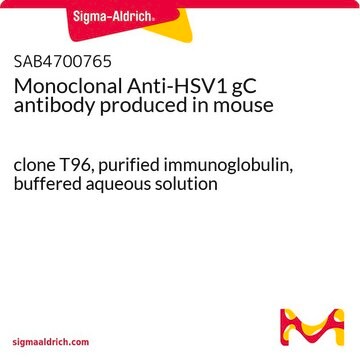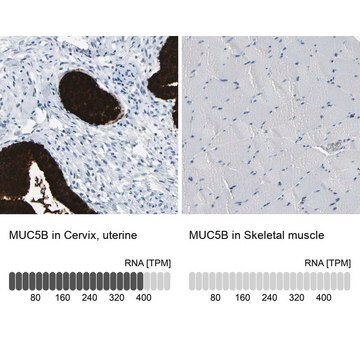추천 제품
생물학적 소스
mouse
Quality Level
100
500
결합
unconjugated
항체 형태
culture supernatant
항체 생산 유형
primary antibodies
클론
MRQ-18, monoclonal
설명
For In Vitro Diagnostic Use in Select Regions (See Chart)
형태
buffered aqueous solution
종 반응성
human
포장
vial of 0.1 mL concentrate (291M-14)
vial of 0.5 mL concentrate (291M-15)
bottle of 1.0 mL predilute (291M-17)
vial of 1.0 mL concentrate (291M-16)
bottle of 7.0 mL predilute (291M-18)
제조업체/상표
Cell Marque™
기술
immunohistochemistry (formalin-fixed, paraffin-embedded sections): 1:50-1:200
동형
IgG1κ
제어
colon
배송 상태
wet ice
저장 온도
2-8°C
시각화
cytoplasmic
유전자 정보
human ... MUC2(4583)
일반 설명
Mucins are a diverse group of complex, highly glycosylated extracellular proteins. Mucin 2 (MUC2) protects the gastric and intestinal epithelium from chemical and mechanical injury. Anti-MUC2 reactivity is normally seen in goblet cells of the small intestine and colon and is associated with mucinous carcinomas, including those of the gastrointestinal tract and ovary. MUC2 immunohistochemistry is useful for identifying colonic, gastric, and esophageal carcinomas.
Mucins are high molecular weight glycoproteins which constitute the major component of the mucus layer that protects the gastric epithelium from chemical and mechanical aggressions. In humans, at least 14 mucin genes have been identified that code for the mucin proteins. They are designated as MUC1, MUC2, MUC3, MUC4, MUC5AC, MUC5B , MUC6 , MUC7, MUC8, MUC9, MUC11, MUC12, MUC13 and MUC16. Mucins share a common feature of a tandem-repeat domain rich in serine and threonine residues. These amino acid residues are potential O-glycosylation sites for attachment of the O-glycan chains that constitute up to 80% of the molecular weight of the final mucin glycoprotein.
The heterogeneous pattern of mucin expression, including the expression of the intestinal mucin MUC2, may provide new insights into the differentiation pathways of gastric carcinoma. The pattern of mucin expression may also be used as a clue to bring new insights into the biological behaviour of distinct clinicopathological entities related to the localisation of gastric carcinoma, namely proximal and distal gastric carcinomas. Pinto-de-Sousa et al. have shown in a comprehensive study of gastric carcinomas evaluated for expression of several mucins (MUC1, MUC2, MUC5AC and MUC6) that: (1) mucin expression is associated with tumour type (MUC5AC with diffuse and infiltrative carcinomas and MUC2 with mucinous carcinomas) but not with the clinico-biological behaviour of the tumours; and (2) mucin expression is associated with tumour location (MUC5AC with antrum carcinomas and MUC2 with cardia carcinomas), indirectly reflecting differences in tumour differentiation according to tumour location.
The following generalities apply to the patterns of Mucin expression:
MUC1 expression: apical surfaces of most epithelial cells in breast, GI, respiratory, and GU tracts.
MUC2 expression: specifically expressed in goblet cells of the small intestine & colon.
Colonic CAs – 65%, Gastric CAs – 42%, Esophageal CAs – 17%
Rare outside of GI tract – with exception of; mucinous ca of breast, clear cell-type CAs of the ovary.
The heterogeneous pattern of mucin expression, including the expression of the intestinal mucin MUC2, may provide new insights into the differentiation pathways of gastric carcinoma. The pattern of mucin expression may also be used as a clue to bring new insights into the biological behaviour of distinct clinicopathological entities related to the localisation of gastric carcinoma, namely proximal and distal gastric carcinomas. Pinto-de-Sousa et al. have shown in a comprehensive study of gastric carcinomas evaluated for expression of several mucins (MUC1, MUC2, MUC5AC and MUC6) that: (1) mucin expression is associated with tumour type (MUC5AC with diffuse and infiltrative carcinomas and MUC2 with mucinous carcinomas) but not with the clinico-biological behaviour of the tumours; and (2) mucin expression is associated with tumour location (MUC5AC with antrum carcinomas and MUC2 with cardia carcinomas), indirectly reflecting differences in tumour differentiation according to tumour location.
The following generalities apply to the patterns of Mucin expression:
MUC1 expression: apical surfaces of most epithelial cells in breast, GI, respiratory, and GU tracts.
MUC2 expression: specifically expressed in goblet cells of the small intestine & colon.
Colonic CAs – 65%, Gastric CAs – 42%, Esophageal CAs – 17%
Rare outside of GI tract – with exception of; mucinous ca of breast, clear cell-type CAs of the ovary.
품질
 IVD |  IVD |  IVD |  RUO |
결합
MUC2 Positive Control Slides, Product No. 291S, are available for immunohistochemistry (formalin-fixed, paraffin-embedded sections).
물리적 형태
Solution in Tris Buffer, pH 7.3-7.7, with 1% BSA and <0.1% Sodium Azide
제조 메모
Download the IFU specific to your product lot and formatNote: This requires a keycode which can be found on your packaging or product label.
기타 정보
For Technical Service please contact: 800-665-7284 or email: service@cellmarque.com
법적 정보
Cell Marque is a trademark of Merck KGaA, Darmstadt, Germany
적합한 제품을 찾을 수 없으신가요?
당사의 제품 선택기 도구.을(를) 시도해 보세요.
시험 성적서(COA)
제품의 로트/배치 번호를 입력하여 시험 성적서(COA)을 검색하십시오. 로트 및 배치 번호는 제품 라벨에 있는 ‘로트’ 또는 ‘배치’라는 용어 뒤에서 찾을 수 있습니다.
Seog-Yun Park et al.
Archives of pathology & laboratory medicine, 131(10), 1561-1567 (2007-10-10)
Although identification of the primary tumor in patients with metastatic adenocarcinoma has a profound clinical impact, diagnosing the organ of origin is frequently difficult. Because none of the individual immunohistochemical markers used for tissue identification are both site specific and
Emad A Rakha et al.
Modern pathology : an official journal of the United States and Canadian Academy of Pathology, Inc, 18(10), 1295-1304 (2005-06-25)
Mucins are a large family of glycoproteins expressed by many epithelial cells and their malignant counterparts. Much interest has been focused on expression of its members in breast cancer because of their potential role as prognostic indicators and their involvement
T Mizoshita et al.
Histology and histopathology, 22(3), 251-260 (2006-12-14)
We have previously demonstrated links between clinicopathological findings and phenotypes using several gastric and intestinal phenotypic markers in stomach and pancreatic cancers. However, the clinicopathological significance of the phenotype and Cdx2 expression has hitherto remained unclear in colorectal carcinogenesis. We
Fionnuala P O'Connell et al.
Archives of pathology & laboratory medicine, 129(3), 338-347 (2005-03-02)
Breast carcinoma often metastasizes to the gastrointestinal tract, especially the stomach, where it is frequently difficult to distinguish from a primary gastric carcinoma. To evaluate the utility of immunohistochemical stains in differentiating primary gastric carcinomas from metastatic breast carcinomas. Mucosal
P Chaves et al.
Diseases of the esophagus : official journal of the International Society for Diseases of the Esophagus, 18(6), 383-387 (2005-12-13)
Intestinal metaplasia is a prerequisite criterion for the diagnosis of Barrett's metaplasia and the sole columnar esophageal lining associated with malignancy. It is recognized by the presence of goblet cells, but columnar non-goblet elements, producing gastric or intestinal proteins, are
자사의 과학자팀은 생명 과학, 재료 과학, 화학 합성, 크로마토그래피, 분석 및 기타 많은 영역을 포함한 모든 과학 분야에 경험이 있습니다..
고객지원팀으로 연락바랍니다.

